Authentic Irish Barmbrack: Traditional Recipe & History
Steeped in tradition, the Irish Barmbrack is a delightful cake that has been enjoyed for generations, particularly during Halloween festivities. This recipe combines simple ingredients like eggs, butter, and dried fruit soaked in tea, creating a loaf that is both rich in flavour and history1.
Originally, this cake was more than just a treat; it was a part of fortune-telling rituals. Items like a ring or a coin were baked into the loaf, each symbolising a different future for the recipient2. Today, the recipe remains largely unchanged, preserving its cultural significance.
To prepare, preheat your oven to 350°F and bake the mixture for about an hour. Once done, let it cool on a wire rack. This process ensures a perfectly moist and aromatic cake that can be stored for up to four days or frozen for longer3.
Join us as we explore the steps to create this traditional cake, celebrating its heritage and the joy it brings to gatherings. Whether you’re a seasoned baker or new to the kitchen, this recipe promises a rewarding experience.
A Rich History of Irish Barmbrack
Rooted in ancient Celtic traditions, this cake has long been a symbol of harvest and fortune. Its origins are deeply tied to the festival of Samhain, which marked the end of the harvest season and the beginning of winter. During this time, families would gather to celebrate with food that carried both sustenance and meaning4.
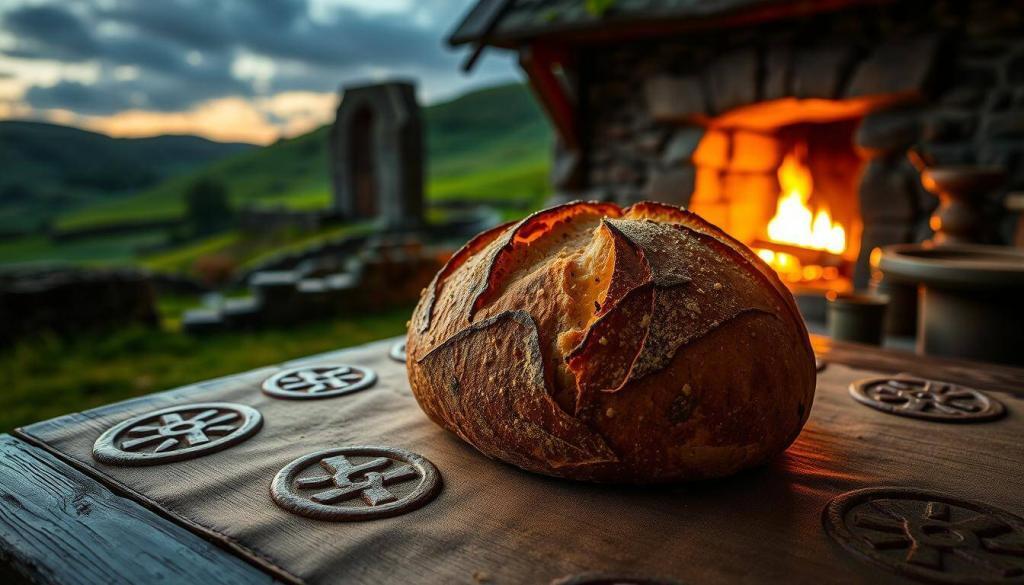
The Celtic Origins and Samhain Traditions
Samhain was a time of transition, where the boundary between the living and the spirit world was believed to blur. Traditional foods like this cake were prepared to honour the season and bring good fortune. Ingredients such as dried fruit, spices, and tea were carefully gathered and preserved for the winter months4.
The cake itself was often baked with a mix of flour, sugar, and soaked fruits, creating a rich and aromatic loaf. These ingredients were not just chosen for their flavour but also for their symbolic significance, representing abundance and prosperity5.
How Charms and Superstitions Influenced the Recipe
One of the most fascinating aspects of this cake is its connection to fortune-telling. Charms like a ring, coin, or piece of cloth were often baked into the loaf, each carrying a specific meaning. For example, finding a ring in your slice was said to predict marriage, while a coin symbolised wealth4.
These superstitions added an element of mystery and excitement to the cake, making it a cherished part of celebrations. Even today, the tradition of including charms continues, though modern bakers often opt for safer alternatives to avoid hazards5.
Through its rich history and cultural significance, this cake remains a beloved symbol of tradition and folklore. Its story is a testament to the enduring power of food to connect us to our past and to each other.
Rediscovering Irish Barmbrack
Rediscovering this traditional cake is like stepping back in time, connecting us to our culinary roots. It’s a journey that brings us closer to the flavours and techniques passed down through generations. Each step in the process, from soaking the fruit to the final bake, is a tribute to the craftsmanship of our ancestors6.
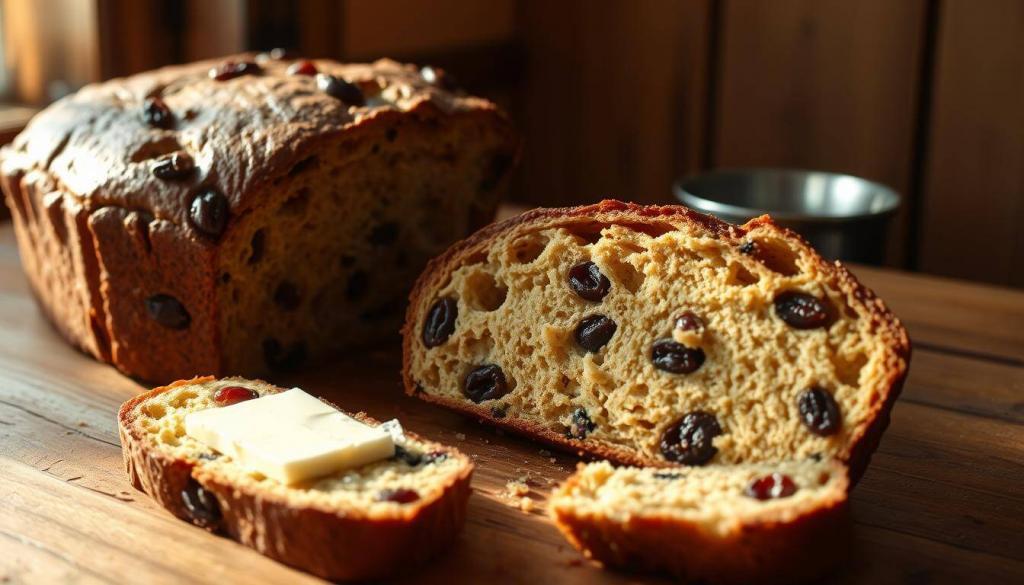
Our Connection to Irish Culinary Heritage
This cake is more than just a recipe; it’s a symbol of our shared history. The use of dried fruit and spice reflects the resourcefulness of past generations, who preserved these ingredients for the winter months7. Every slice carries the essence of Samhain, a festival that celebrated the harvest and the transition into winter6.
We take pride in keeping these traditions alive. By following the precise timings and techniques, we ensure that the cake retains its unique texture and flavour. It’s a way to honour the past while creating new memories with loved ones8.
Why We Cherish This Traditional Cake
What makes this cake so special is the care and attention that goes into every step. The zest of citrus fruits adds a refreshing note, while the blend of spices creates a warm, comforting aroma. Baking it is not just about the result; it’s about the process and the stories it carries7.
Here’s why we hold this recipe dear:
- It strengthens our cultural roots, reminding us of where we come from.
- The minute details, like soaking the fruit in tea, contribute to its distinctive taste.
- It’s a celebration of traditional techniques, blended with modern practices.
This cake is a testament to the enduring power of food to connect us to our heritage. By baking it, we keep a piece of history alive, one slice at a time8.
Step-by-Step Guide to the Authentic Recipe
Crafting this traditional cake is a journey through time, blending history with hands-on baking. We’ll walk you through each step, from preparing the ingredients to the final bake, ensuring you create a cake that’s both authentic and delicious.
Preparing Your Ingredients: Flour, Dried Fruit, and Spices
Start by gathering your ingredients. You’ll need 2 cups of all-purpose flour, 2.25 cups of dried fruit (a mix of raisins, currants, and cherries), and a blend of warm spices like cinnamon, cloves, and nutmeg9. These ingredients form the foundation of the cake, giving it its distinctive flavour and texture.
Don’t forget the zest and juice of a medium orange and lemon. These add a refreshing citrus note that balances the richness of the dried fruit10.
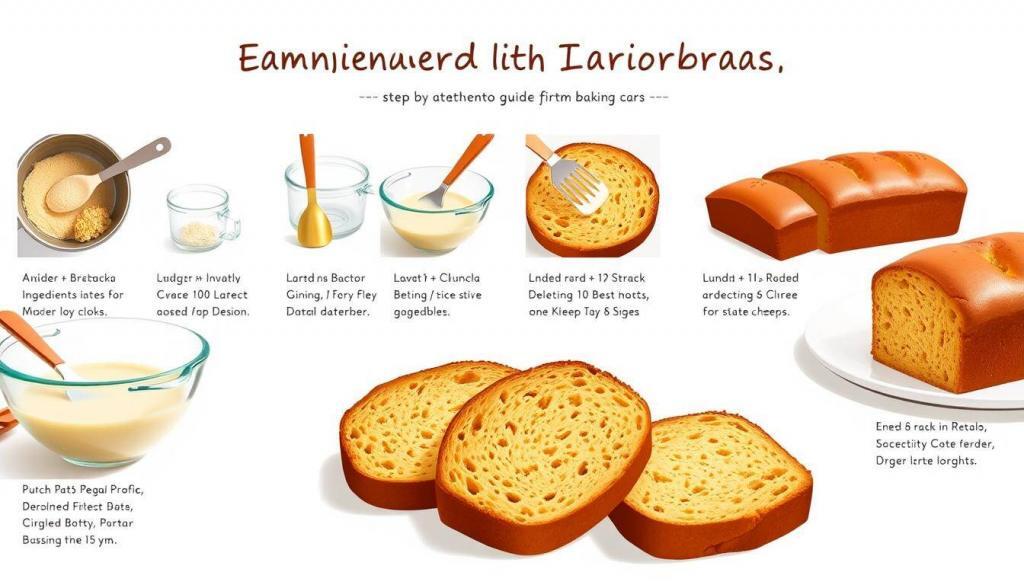
The Art of Soaking with Tea and Incorporating Charms
Soaking the dried fruit is a crucial step. Place the fruit in a bowl and pour hot tea over it, using 2 black tea bags for maximum flavour. Let it soak overnight, allowing the fruit to plump up and absorb the tea9.
Once soaked, fold the fruit into a light mixture of beaten eggs, sugar, and marmalade. This ensures the cake remains moist and flavourful. If you’re feeling traditional, add charms like a ring or coin to the batter. These add an element of fun and tradition to your bake11.
Baking Techniques from Preheating the Oven to Cooling on a Wire Rack
Preheat your oven to 350°F (175°C) while you prepare the batter. Pour the mixture into a greased baking tin and bake for 45 minutes to an hour, or until a skewer comes out clean9.
Once baked, let the cake cool on a wire rack. This ensures it sets properly and retains its moisture. Slice and serve, or store for up to four days for continued enjoyment10.
Mastering the Perfect Irish Barmbrack
Perfecting this traditional loaf requires attention to detail and a blend of time-honoured techniques. Whether you’re a seasoned baker or just starting, these tips will help you create a bread that’s both moist and flavourful.
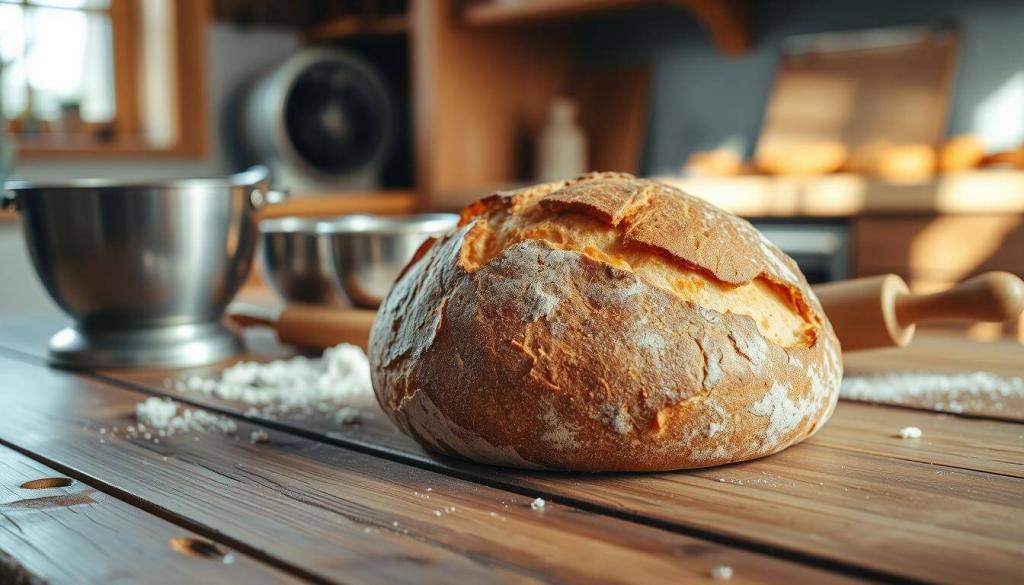
Essential Tips for a Flavourful Loaf
To achieve the best results, start by measuring your ingredients carefully. A well-measured cup of raisins and other dried fruits ensures consistency in every bite12. Soaking the fruit in tea overnight enhances moisture, giving the bread its signature texture13.
Handle the dough gently to avoid overmixing. Fold in the raisins and spices with care, ensuring they’re evenly distributed. This step is crucial for a balanced flavour throughout the loaf14.
How to Achieve the Ideal Texture and Moisture
The key to a perfect texture lies in the dough’s consistency. If it feels too dry, add a splash of milk. If it’s too wet, sprinkle in a bit of ground flour to balance it out13.
Once baked, let the bread cool on a wire rack. This allows it to set properly and retain its moisture. For an extra touch, brush the top with a sugar syrup glaze to enhance both appearance and flavour12.
Here are some practical tips to keep in mind:
- Use chilled butter for a richer texture.
- Ensure the dough doubles in size during the rising period.
- Bake at 180°C for about 90 minutes, or until a skewer comes out clean12.
By following these steps, you’ll create a loaf that’s not only delicious but also a testament to traditional baking methods. Happy baking!
Exploring Variations and Modern Twists
Modern bakers are putting their own spin on traditional recipes, blending innovation with heritage. While the classic loaf remains a favourite, there’s room to experiment with ingredients and techniques. This approach allows each person to create a unique version while honouring the essence of the original.
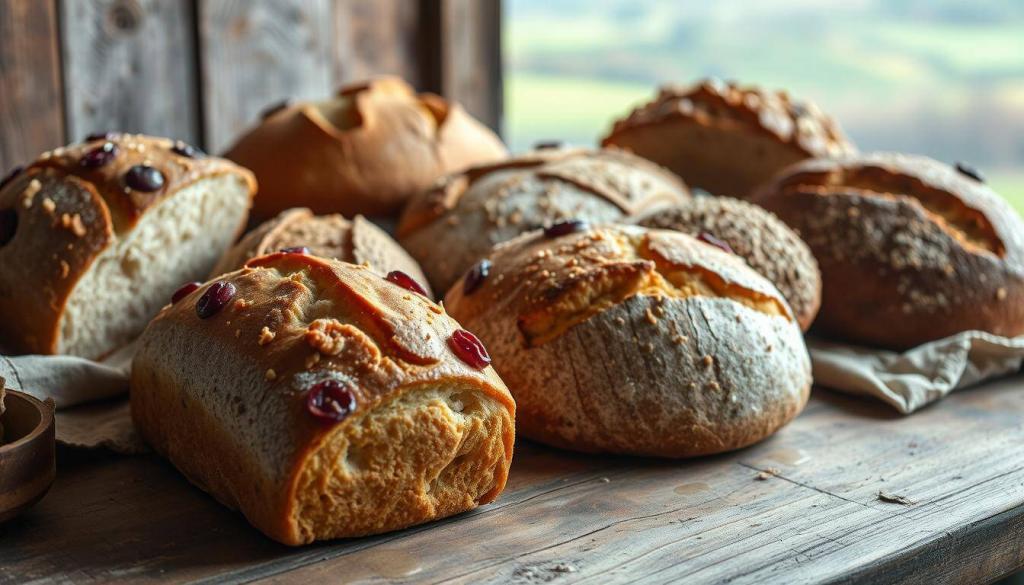
Substituting Ingredients for a Contemporary Touch
One way to modernise the recipe is by adjusting the dough consistency. Adding a measured teaspoon of spices or a splash of whiskey can elevate the flavour profile. Whiskey, in particular, adds a subtle richness that complements the dried fruit beautifully15.
For a refreshing twist, consider incorporating lemon zest into the mix. Its citrusy notes balance the sweetness of the dried fruit, creating a harmonious blend. Experimenting with different combinations of dried fruit, such as apricots or cranberries, can also add a personal touch16.
Here are some ideas to inspire your creativity:
- Use wholemeal flour for a nuttier texture and added fibre.
- Add a teaspoon of honey or treacle for a hint of sweetness.
- Replace tea with orange juice for a fruity twist.
These variations allow you to tailor the recipe to your taste while preserving its traditional charm. Whether you’re adding whiskey or experimenting with dried fruit, the possibilities are endless.
Wrapping Up Our Irish Barmbrack Journey
As we conclude our exploration, we reflect on the rich heritage and meticulous craft behind this beloved treat. From carefully measuring ingredients like 400g of dried fruit and 300ml of tea to ensuring the dough rises perfectly in a 23x15cm tin, every step is a nod to tradition17.
Preheating the oven to 130°C and baking for at least an hour and forty minutes ensures a golden, moist loaf. Once baked, wrapping it in parchment paper allows the flavours to develop fully, a practice cherished by generations18.
We invite you to try this recipe, embracing the blend of history and modern techniques. Share your experiences with us, and let’s continue celebrating this cultural legacy together. Happy baking!
Source Links
- Traditional Irish Barmbrack – Gemma’s Bigger Bolder Baking – https://www.biggerbolderbaking.com/traditional-irish-barmbrack/
- Barmbrack – https://en.wikipedia.org/wiki/Barmbrack
- Traditional Irish Barmbrack Recipe – https://notentirelyaverage.com/irish-barmbrack/
- Irish Halloween food traditions: Where did barmbrack get its name, and why is champ important? – https://www.independent.ie/life/food-drink/irish-halloween-food-traditions-where-did-barmbrack-get-its-name-and-why-is-champ-important/37453192.html
- Memories of traditional Halloween barmbrack growing up in Ireland – https://www.irishcentral.com/culture/food-drink/halloween-barmbrack-traditions-memories
- Your guide to the foods associated with Halloween in Ireland – https://www.rte.ie/brainstorm/2020/1029/1174613-halloween-food-ireland-barmbrack-colcannon-apples-pumpkins-turnips-kale/
- Irish cuisine – https://en.wikipedia.org/wiki/Irish_cuisine
- Halloween Bread – Barmbrack – The Traveling Delanys – https://thetravelingdelanys.com/halloween-bread-barmbrack/
- St. Patrick’s Day recipe: Irish barmbrack (fruit and tea loaf) – https://www.csmonitor.com/The-Culture/Food/Stir-It-Up/2016/0317/St.-Patrick-s-Day-recipe-Irish-barmbrack-fruit-and-tea-loaf
- Tasty, Traditional Irish Barmbrack Bread (Báirín Breac Fruit Bread) – https://bakeitwithlove.com/irish-barmbrack-fruit-bread/
- Barmbrack – A Traditional Fruity Bread From Ireland – https://www.irishamericanmom.com/barmbrack-a-traditional-fruity-bread-from-ireland/
- The perfect Irish barmbrack recipe | Felicity Cloake – https://www.theguardian.com/lifeandstyle/2018/mar/17/barmbrack-recipe-fruit-loaf-felicity-cloake
- Barmbrack – North/South Food – https://www.northsouthfood.com/barmbrack/
- Butterfly Buns, Barmbrack and Soda Bread: The Secrets of Irish Baking – https://www.177milkstreet.com/radio/butterfly-buns-barmbrack-and-soda-bread-the-secrets-of-irish-baking
- IRISH BREAD: FROM SODA BREAD TO BARMBRACK, A JOURNEY THROUGH IRELAND’S BREAD HERITAGE – https://irishfoodhub.com/irish-bread-from-soda-bread-to-barmbrack-a-journey-through-irelands-bread-heritage/
- Uncover the Rich Heritage of Irish Bread Baking – https://amazingfoodanddrink.com/exploring-heritage-irish-bread-baking/
- Barmbrack Irish Bread – https://www.notquitenigella.com/2020/10/30/barmbrack-bread-irish/
- Barmbrack | Irish Tea Bread – https://foodandtools.com/2015/01/11/barmbrack-irish-tea-bread/
Footer 1
Call the HERD
Always available for any questions. Call and we will be happy to help.
Follow the HERD
Keep up to date on new products available in store.
Important Links
Join the HERD
Be the first to know about any offers or promotions.
- Herd Butchery 2025

Leave a Reply